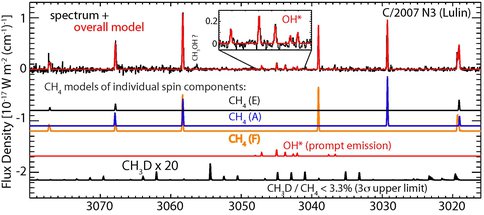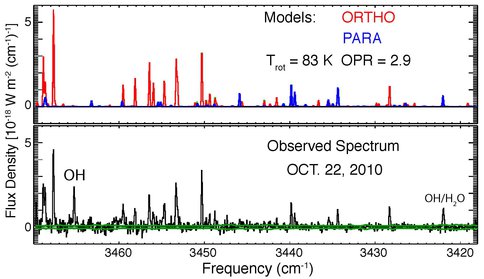2011 Annual Science Report
 NASA Goddard Space Flight Center
Reporting | SEP 2010 – AUG 2011
NASA Goddard Space Flight Center
Reporting | SEP 2010 – AUG 2011
Composition of Parent Volatiles in Comets
Project Summary
During the period covered by this progress report we conducted an extensive observing campaign on the Jupiter-family comet 103P/Hartley-2 – the target of the EPOXI fly-by mission. We studied the volatile composition of two other Jupiter-family comets – 10P/Tempel-2 and 21P/Giacobini-Zinner. We continued our multi-comet surveys of spin temperatures and searches for deuterated species. We characterized the abundances of several prebiotic molecules in comet C/2007 N3 Lulin. We also organized NAI-funded “Workshop on cometary taxonomies” held in Annapolis, MD
Project Progress
1. The Comet 103P/Hartley-2 Campaign
We conducted an extensive observing campaign on the Jupiter-family comet 103P/Hartley-2 – the target of the EPOXI fly-by mission. Our group studied the volatile composition using the NIRSPEC instrument at the Keck 2 telescope atop Mauna Kea, Hawaii. We quantified the long- and short-term behavior of volatile release over a three-month interval that encompassed the comet’s closest approach to Earth, its perihelion passage, and flyby of the comet by the Deep Impact spacecraft during the EPOXI mission. It should be truly appreciated that such an extensive coverage at near-infrared wavelengths with NIRSPEC/Keck 2 (the principal instrument/facility for infrared high-resolution molecular spectroscopy) is unique. We acquired a wealth of data, conducted a detailed analysis, and published our initial results in the special issue of The Astrophysical Journal Letters (June 10, 2011) dedicated to Hartley-2 (Mumma et al. 2011).
Our 103P/Hartley-2 findings were disseminated quickly and presented a great immediate interest. In addition to the refereed publication, Mumma and Bonev gave contributed talks at the special session on Hartley-2 organized during the Lunar and Planetary Science conference (March, 2011) and Bonev gave an invited talk at the University of Maryland, attended by the leading EPOXI investigators (PI M. A’Hearn; J. Sunshine) and a number of ground-based observers.
Contributions: Our measurements of parent volatiles with NIRSPEC/Keck 2 were critical to understanding the composition of the ices stored in its nucleus. These measurements could not be reproduced by either other ground-based facilities or with the instrumentation available at the spacecraft. Our campaign on Hartley-2 emphasized both the long-term (months) and short-term (hours to days) behavior of gas release from its nucleus. We found clear evidence for heterogeneous outflow and at the same time, we demonstrated that the bulk composition of the coma (averaged over various discrete vents) remained constant (to a small degree of uncertainty) throughout the apparition. This result is not trivial and provides a key context in interpreting data taken with both space-craft instrumentation (at much lower spectral resolution) and the extensive ground-based work done at optical wavelengths, which do not sample emission from parent volatiles directly.
2. The composition of “ecliptic” comets
Comets “injected” from the scattered Kuiper disk (the so called “ecliptic” comets) are generally fainter and more often present a larger challenge to modern high-resolution spectrometers than Oort cloud comets. For this reason, compositional studies of these objects are especially valuable. In the period covered by this progress report, we characterized parent volatile abundances and water spin temperatures in three ecliptic comets: 103P/Hartley-2 (see above), 10P/Tempel-2, and 21P/Giacobini-Zinner.
Contribution: Jupiter-family comets are ecliptic comets that have evolved to short-period orbits, a dynamical end state to their existence. A major open question is whether their volatile composition, as observed through parent molecules in the cometary atmosphere, reflects the formation heritage of their pre-cometary ices (which is most relevant to astrobiology) or instead is a consequence of thermo-chemical evolution resulting from multiple perihelion passages. Our study of 21P/Giacobini-Zinner strongly suggests the former – this was the first comet for which parent volatiles (CH3OH, C2H6, and H2O) were characterized over two separate apparitions (orbital periods), and the abundances of CH3OH and C2H6 (relative to H2O) were unchanged within observational error. This demonstrates that the composition of its active layers did not vary with depth in the nucleus despite significant surface erosion (up to about 1 meter depth per perihelion passage).
3. Spin temperatures in comets
The “spin temperature” is a characteristic of cometary primary (i.e. released from ices stored in the nucleus) molecules which contain identical nuclei, such as H2O and CH4. We most recently determined spin temperatures for H2O in the Jupiter-family comets Hartley-2, 10P/Tempel 2, and 21P/ Giacobini-Zinner, and in the Oort cloud comets C/2007 W1 (Boattini), and C/2007 N3 (Lulin). These are now either published (Hartley-2; Boattini), submitted for publication (10P/Tempel 2), or included in manuscripts in preparation (Lulin, Giacobini-Zinner). We also measured spin temperature of methane (CH4) in comet Lulin. This is one of the few measurements for cometary methane and it is in a good agreement with the independently measured value for H2O.
Contribution: We are testing the hypothesis that these spin temperatures are “cosmogonic thermometers”, i.e. they relate to the chemical formation temperature of the observed molecules. A major “puzzle” from earlier measurements has been the prevailing perception in the field, namely that the spin temperatures in all comets are the same and are clustered near 30 K. Our multi-comet survey has gradually challenged this “30 K paradigm” because we are also finding higher values (> 40 – 50 K). This is triggering (long-overdue) investigation on systematic uncertainties introduced by different observing techniques which very likely provide a major bias on any inter-comparison between measurements and their interpretation. Thus, our work is not only adding to the small number of spin temperature measurements, but (more importantly) also outlines and quantitatively investigates these key issues biasing deeper interpretation.
4. Prebiotic molecules in comet Lulin
Stardust samples revealed (after ruling out terrestrial contamination) organic volatile compounds of keen interest for understanding the emergence of life on Earth: NH2CH2COOH (glycine), CH3NH2 (methylamine), and CH3CH2NH2 (ethylamine). While about 70 amino acids have been found in meteorites, glycine is the first amino acid discovered in a comet. More sensitive laboratory techniques are being developed to conduct future searches for other amino acids and possibly sugars. These prebiotic compounds could originate in space environments from HCN and NH3 (leading to amino acids), H2CO (leading to sugars), C2H6 and CH4 (suggested precursors of ethyl- and methylamine), all of which we study in comets. The abundances of HCN, NH3, H2CO, C2H6, CH4, along with several other simple organic molecules (e.g., C2H2, CH3OH) were most recently measured in comet C/2007 N3 (Lulin).
Contribution: In comparison with other comets we found that HCN and H2CO were depleted, C2H6 and CH4, close to current mean among observed comets, while CH3OH was substantially enriched. Such prebiotic volatile chemistry is not common based on previous observations of comets. It illustrates the importance of continuing studies of these molecules in comets (and other space environments) in order to better understand the synthesis of the more complex prebiotic compounds. In this, our comet team collaborates with the laboratory astrochemistry group (that detected amines and searched amino acids in Stardust samples) within the Goddard Center for Astrobiology (GCA). Our main goal is to trace the formation pathways of prebiotic organics in space and to assess the possibility for their exogenous delivery to early Earth hypothesized as a precursor for the emergence of life.
5. Searches for deuterated water and methane
We conducted sensitive searches for HDO (simultaneously with H2O or its proxy OH “prompt emission”) and CH3D (simultaneously with CH4) in order to constrain the D/H ratio in cometary water and methane respectively. D/H might be an important indicator of both the formation temperature and the chemical formation pathways of molecules eventually “frozen” into cometary nuclei. During the period covered by the progress report, we searched for HDO and CH3D in comets C/2007 N3 (Lulin) and 103P/Hartley-2. This adds to the earlier studies in 8P/Tuttle (HDO) and C/2004 Q2 (Machholz) (CH3D).
Contribution: Our CH3D/CH4 upper limit in C/2007 N3 (Lulin) is highly meaningful to test a range of astrochemical models and provides one of the few constraints for deuterated methane in comets. With moderate time on source we achieved sensitivities in HDO/H2O comparable to those from other techniques applied to substantially brighter comets. Analyses are ongoing.
6. We organized the first “Workshop on Cometary Taxonomies” held in Annapolis, MD on March 13-16, 2011. This activity was organized by GCA and Catholic University of America and funded through the NAI. The workshop enabled synergistic interpretation of (1) multi-wavelength observational studies of cometary composition, (2) dynamical models for the early solar system, with implication to the delivery of water and prebiotic matter to early Earth, and (3) state-of-the-art astrochemical models predictive the chemical synthesis of volatiles and the evolution of volatile matter during solar system formation prior to its incorporation into comets. Participants not only reported progress, but also outlined critical problems to be addressed in understanding the composition of comets and testing the contribution of comets to the exogenous delivery of prebiotic organics and water to early Earth. We are planning a follow up workshop within the current funding period.
Figure 1. Detection of methane (CH4) in comet C/2007 N3; the three nuclear spin species of CH4 (A-, E-, and F-) are modeled separately (blue, black, and orange) because radiative transitions between them are strongly forbidden. From this spectrum we determined the methane spin temperature. Also shown is a sensitive search for CH3D (bottom, black). The model is expanded by 20 to illustrate the line positions. The resulting CH3D/CH4 upper limit is highly meaningful and provides one of the few constraints for CH3D in comets (see discussion: §2.3). Inset: Detection and a best-fit model of OH* prompt emission.
Figure 2. Water emission in Jupiter-family comet 103P/Hartley-2 indicating ortho- and para- emission. Our analyses indicate that the the spin temperaturee of water is consistent with statistical equilibrium (Tspin ~ 55 K or higher).
Workshop on the Chemical Taxonomy of Comets, 14-16 March 2011, Annapolis, MD
GCA hosted the first Workshop on Cometary Taxonomy, held March 14-16 in Annapolis, MD. Drs. Michael J. Mumma and Steven B. Charnley were co-convenors, and Dr. Stefanie N. Milam (691) chaired the Local Organizing Committee (members, Corinne M. Eby and Dr. Boncho P. Bonev, Catholic University). The Invitational Workshop (30 participants) was sponsored by the Goddard Center for Astrobiology, the NASA Astrobiology Institute, and The Catholic University of America. It was conducted in the style of a Gordon Research Conference, and included experts from Taiwan, Japan, France, Belgium, Germany, United Kingdom, and the United States. The scope encompassed the entire temporal span of Planetary System formation, including chemistries in the interstellar natal cloud core and protoplanetary disk, dynamical evolution of material in the disk (Nice 2.0), the compositional signatures of ices and rocky dust in comets, and the taxonomic classification of icy bodies within the principal cometary reservoirs. The emerging taxonomies (based on composition of ices and dust) received major attention, in an attempt to identify congruence and divergence amongst the various taxonomies. Insights gained from space missions to recent comets (Hartley 2, Tempel 1, and Borrelly) and from laboratory investigation of authentic samples returned from comet Wild 2 by Stardust capped the Workshop.
Publications
-
Mumma, M. J., & Charnley, S. B. (2011). The Chemical Composition of Comets—Emerging Taxonomies and Natal Heritage. Annu. Rev. Astro. Astrophys., 49(1), 471–524. doi:10.1146/annurev-astro-081309-130811
-
PROJECT INVESTIGATORS:
-
RELATED OBJECTIVES:
Objective 2.2
Outer Solar System exploration
Objective 3.1
Sources of prebiotic materials and catalysts
Objective 4.1
Earth's early biosphere.


